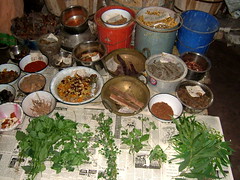A small group of young rural women had an idea to uplift their community. They met an illustrious man named Mr. P.K. Roy who advised them to create a self-employment organization for themselves and other women in need of such a service. Each of them raised 800 rupees to get the project started. They began training, first for themselves, and then starting training other women coming for below the poverty line within the nearby villages. By the year 1991, Mr. Roy was able to withdraw himself and move onto other projects, seeing that these extremely enthusiastic women had themselves formed a sustainable and firm infrastructure with professional leadership and a global outlook. Now this highly-functional project, Sunderbans Village Khadi and Industrial Society (SKVIS), works as an umbrella group for no less than 12,000 families and is proud to provide such an important network for the education and livelihood of women of the Sunderbans, which is the mangrove region home to the dwindling Bengal Tiger population, located about 52 miles south of Kolkata along the delta border of India and Bangladesh.
At the end of February 2005, quite by chance through a job I am doing, I had the opportunity to visit SKVIS in Canning and was shown around by several of the founding 9 members. The moment I stepped into the training center I could feel something different altogether at work here. The first room I stepped into, I saw women painting wax designs directly onto fabrics for batik, three artists at home in their studio. They hadn't even needed to put down lines to follow, simply following their heart's own lines and designs and their hand's confident experience. Although I have always tried to support fair trade, seeing this art being done in front of my eyes made a much deeper impression on me than ever before. I felt as though the women should all be signing their pieces as they are each a small masterpiece. In the next room, I met Sushama who was very keen to show me all the variations on plant colors she had been researching in her spare time. She was dying bio-cotton fabrics and handmade paper and the colors, textures and smells in the room were invigorating. In the same room, some women were doing block print patterning on silk sashes, which I later found out was an order for Global Village, a group in Japan that I am very familiar with. After lunch I saw the tailoring section, handloom weaving, and dying areas and talked to many of the women working there. When I asked how they learned these skills, they told me "here at SKIVS!" In the tailoring room, women were sewing beautiful cotton sarongs...these also heading to Japan for Global Village! I felt so at home and so proud to be a part of this special socio-economic loop, knowing exactly where these products were headed. I didn't have time to go out into the villages and see the agricultural projects also being conducted through SKVIS but will be sure to visit there again.
From this visit, I also came to understand the importance of the Azo-free dyes that Safia Minney at Global Village insists upon. Because the women come in close contact with the dyes and can be exposed to dangerous carcinogens if they are azo type dyes, the azo-free are the best choice for the producers, the consumers, and the planet. I felt truly lucky to meet such powerfully empowered women working so close to me. Fair Trade customers can really be proud to buy such artful products and support this good work. Each and every woman I met was an artisan in her own right.

No comments:
Post a Comment